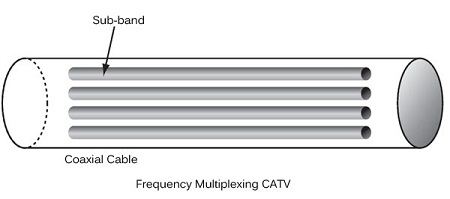A Cable Modem provides bi-directional data communication via radio frequency channels on a cable television (CATV) infrastructure. Cable modems are primarily used to deliver broadband Internet access in the form of cable Internet, taking advantage of the high bandwidth of a cable television network.
Cable operators have an environment where they can connect the user to one or more operators. This wiring is formed from the CATV coaxial cable connecting the headend to users, as illustrated in figure. TV channels in the downlink direction are broadcast on all branches of the wiring. In the uplink direction, the channels must be superimposed on the tree.

The wiring from a headend to reach the user after a broadcast on all branches. As part of the television broadcasting, different programs are pushed to users. Each subscriber receives all channels and selects one to view. This technique is the opposite of ADSL, where only the user-selected channel is routed.
In the CATV, a frequency multiplexing is used for the transport of the different television channels. The frequency division gives rise to sub-bands, each sub-band with a television channel.

A narrow band can be assigned, of 32 or 64 kbit / s per user, for transporting speech between the telephone handset of the user and the network head which is connected to a telecommunications operator.
It is possible to book a sub-band for connecting to an ISP type operator. This sub-band must however be sufficient to support the sum of users ridges rates. For example, 1,000 users connected to 1 Mbit / s require a total flow potential of 1 Gbit / s. The solution to this problem is to choose on a broadband CATV and using a multiplexing technique to get maximum number of users simultaneously.
The figure illustrates a shared bandwidth of CATV in North America and Europe. The uplink bands in Europe are between 5 and 42 MHz and have a width of 200 kHz to 3.2 MHz. The descending strips are between 50 and 850 MHz. Television bands width is 8 MHz. The number of uplink and downlink bands is left free to operators. The values for North America are shown in the figure. Television bands are 6 MHz.

To perform the multiplexing of the users about the town band, three standards were proposed:
• IEEE 802.14, which uses ATM technology.
• MCNS-DOCSIS, which is used primarily in North America but that European cable operators have adopted thereafter.
• DVB-DAVIC.
Cable modem service is the competitive threat that’s caused phone companies to accelerate their ADSL efforts. The same network that brings you dozens of TV channels can now bring you millions of Web sites. The problem is that the cable network was designed to move information in one direction, from the broadcaster to you.
Downstream speeds are good but upstream speed depends on line quality. Large cable companies are spending money to upgrade their networks to hybrid fiber-coax (HFC) to better handle two-way traffic. Smaller providers can’t afford the upgrade, so you use a phone line at 28.8Kbps for upstream data.
 Dinesh Thakur holds an B.C.A, MCDBA, MCSD certifications. Dinesh authors the hugely popular
Dinesh Thakur holds an B.C.A, MCDBA, MCSD certifications. Dinesh authors the hugely popular